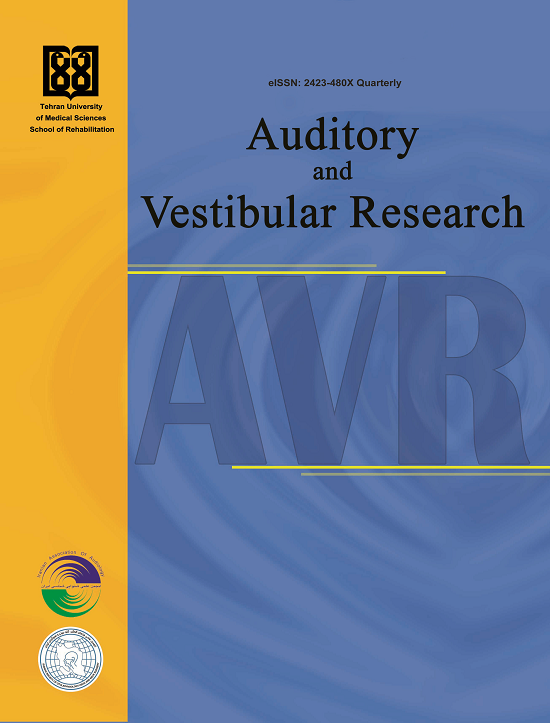Reliability and validity of the Persian version of the 12-items Tinnitus Primary Function Questionnaire
Abstract
Background and Aim: Tinnitus, the perception of sound without an external source, creates social, psychological, and economic challenges. Questionnaires are widely used to assess its impact on daily life. This study aimed to translate and validate the Persian version of the 12-item Tinnitus Primary Function Questionnaire (P-TPFQ-12) to provide a culturally appropriate tool for evaluating tinnitus-related disability in Persian speakers.
Methods: A cross-sectional study was conducted with 56 adults experiencing chronic tinnitus. The P-TPFQ-12 was translated using the International Quality of Life Assessment protocol. Content validity was evaluated using the Content Validity Ratio (CVR) and Content Validity Index (CVI) based on ratings from 10 audiologists. The Face Validity Index (FVI) was calculated with input from 10 experts and 10 patients. Internal consistency was determined using Cronbach’s alphaand item–total correlations. Convergent validity was tested by correlating P-TPFQ-12 scores with the Tinnitus Handicap Inventory (THI), Beck Depression Inventory-II (BDI-II), and Pittsburgh Sleep Quality Index (PSQI). Test–retest reliability was assessed with intraclass correlation coefficients (ICC) in 21 participants after two weeks. Confirmatory factor analysis (CFA) examined two structural models.
Results: Content and face validity were excellent (CVR=1.0, CVI=1.0, FVI=1.0). Internal consistency was high (Cronbach’s α=0.956 overall; subscales=0.922–0.969). Strong correlations were found with THI (r=0.845), moderate with BDI-II (r=0.600) and PSQI (r=0.416). Test–retest reliability was strong (ICC=0.956). CFA supported a four-factor structure with high loadings (0.85–0.97).
Conclusion: The P-TPFQ-12 showed excellent reliability and validity, confirming its suitability as a concise, multidimensional tool for assessing tinnitus-related disability among Persian speakers.
2. Jalessi M, Farhadi M, Asghari A, Kamrava SK, Amintehran E, Ghalehbaghi S, et al. Tinnitus: an epidemiologic study in Iranian population. Acta Med Iran. 2013;51(12):886-91.
3. Han BI, Lee HW, Kim TY, Lim JS, Shin KS. Tinnitus: Characteristics, causes, mechanisms, and treatments. J Clin Neurol. 2009; 5(1):11-9. [DOI:10.3988/jcn.2009.5.1.11]
4. Tunkel DE, Bauer CA, Sun GH, Rosenfeld RM, Chandrasekhar SS, Cunningham ER, Jr., et al. Clinical practice guideline: Tinnitus executive summary. Otolaryngol Head Neck Surg. 2014; 151(4):533-41. [DOI:10.1177/0194599814547475]
5. Newman CW, Jacobson GP, Spitzer JB. Development of the Tinnitus Handicap Inventory. Arch Otolaryngol Head Neck Surg. 1996; 122(2):143-8. [DOI:10.1001/archotol.1996.01890140029007]
6. Kuk FK, Tyler RS, Russell D, Jordan H. The psychometric properties of a tinnitus handicap questionnaire. Ear Hear. 1990; 11(6):434-45. [DOI:10.1097/00003446-199012000-00005]
7. Meikle MB, Henry JA, Griest SE, Stewart BJ, Abrams HB, McArdle R, et al. The tinnitus functional index: Development of a new clinical measure for chronic, intrusive tinnitus. Ear Hear. 2012; 33(2):153-76. [DOI:10.1097/AUD.0b013e31822f67c0]
8. Rolstad S, Adler J, Rydén A. Response burden and questionnaire length: Is shorter better? A review and meta-analysis. Value Health. 2011;14(8):1101-8. [DOI:10.1016/j.jval.2011.06.003]
9. Langguth B, Goodey R, Azevedo A, Bjorne A, Cacace A, Crocetti A, et al. Consensus for tinnitus patient assessment and treatment outcome measurement: Tinnitus Research Initiative meeting, Regensburg, July 2006. Prog Brain Res. 2007; 166:525-36. [DOI:10.1016/S0079-6123(07)66050-6]
10. Tyler R, Ji H, Perreau A, Witt S, Noble W, Coelho C. Development and validation of the tinnitus primary function questionnaire. Am J Audiol. 2014; 23(3):260-72. [DOI:10.1044/2014_AJA-13-0014]
11. Shin J, Heo S, Lee HK, Tyler R, Jin IK. Reliability and validity of a Korean version of the tinnitus primary function questionnaire. Am J Audiol. 2019; 28(2):362-8. [DOI:10.1044/2018_AJA-18-0131]
12. Xin Y, Tyler R, Yao ZM, Zhou N, Xiong S, Tao LY, et al. Tinnitus assessment: Chinese version of the tinnitus primary function questionnaire. World J Otorhinolaryngol Head Neck Surg. 2022; 9(1):27-34. [DOI:10.1002/wjo2.60]
13. Lu T, Liu JH, Li G, Xiang T, Ma Y, Zhong J, et al. Reliability and validity of the Mandarin version of the tinnitus primary function questionnaire: A preliminary observational study. Medicine. 2019; 98(25):e16104. [DOI:10.1097/MD.0000000000016104]
14. Talaat HS, Ali RH, Zein El Abedein AM. Trans-adaptation and standardization of Arabic version of tinnitus primary function questionnaire. Egypt J Ear, Nose Throat Allied Sci. 2020; 21(2):51-5. [DOI:10.21608/ejentas.2019.13299.1116]
15. Coradini PP, Gonçalves SN, Oiticica J. Translation and validation of the Tinnitus Primary Function Questionnaire into Brazilian Portuguese. Braz J Otorhinolaryngol. 2022; 88 Suppl 3(Suppl 3):S109-16. [DOI:10.1016/j.bjorl.2022.06.004]
16. Shaurya Ch, Ravichandran A, Kumar S. Transadaptation and standardization of tinnitus primary function questionnaire in Hindi. Int Tinnitus J. 2018; 22(1):23-9. [DOI:10.5935/0946-5448.20180004]
17. Namvar Arefi H, Haddadi Aval M, Ranjbar N, Jafarzadeh S. The Translation and Psychometric Evaluation of the Persian Version of Iowa Tinnitus Primary Function Questionnaire. Aud Vestib Res. 2023; 32(3):213-8. [DOI:10.18502/avr.v32i3.12937]
18. Gorsuch R. Factor analysis (2nd ed.). Hillsdale, NJ: Lawrence Erlbaum Associates; 1983.
19. Chermak GD, Dengerink JE. Characteristics of temporary noise-induced tinnitus in male and female subjects. Scand Audiol. 1987; 16(2):67-73. [DOI:10.3109/14992028709042158]
20. Mahmoudian S, Shahmiri E, Rouzbahani M, Jafari Z, Keyhani M, Rahimi F, et al. Persian language version of the "Tinnitus Handicap Inventory": Translation, standardization, validity and reliability. Int Tinnitus J. 2011; 16(2):93-103.
21. Ghassemzadeh H, Mojtabai R, Karamghadiri N, Ebrahimkhani N. Psychometric properties of a Persian-language version of the Beck Depression Inventory--Second edition: BDI-II-PERSIAN. Depress Anxiety. 2005; 21(4):185-92. [DOI:10.1002/da.20070]
22. Farrahi Moghaddam J, Nakhaee N, Sheibani V, Garrusi B, Amirkafi A. Reliability and validity of the Persian version of the Pittsburgh Sleep Quality Index (PSQI-P). Sleep Breath. 2012; 16(1):79-82. [DOI:10.1007/s11325-010-0478-5]
23. Aaronson NK, Acquadro C, Alonso J, Apolone G, Bucquet D, Bullinger M, et al. International quality of life assessment (IQOLA) project. Qual Life Res. 1992; 1(5):349-51. [DOI:10.1007/BF00434949]
24. Yusoff MSB. ABC of response process validation and face validity index calculation. Educ Med J. 2019; 11(3):55-61. [DOI:10.21315/eimj2019.11.3.6]
25. Koo TK, Li MY. A guideline of selecting and reporting intraclass correlation coefficients for reliability research. J Chiropr Med. 2016; 15(2):155-63. [DOI:10.1016/j.jcm.2016.02.012]
| Files | ||
| Issue | Articles in Press | |
| Section | Research Article(s) | |
| Keywords | ||
| Tinnitus questionaries tinnitus primary functional questionaries validity reliability | ||
| Rights and permissions | |

|
This work is licensed under a Creative Commons Attribution-NonCommercial 4.0 International License. |






